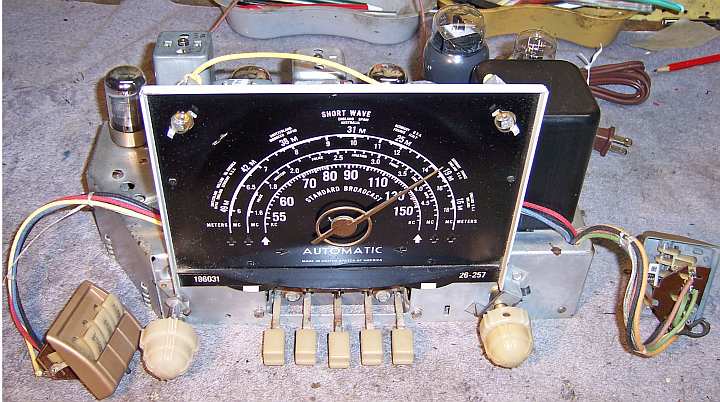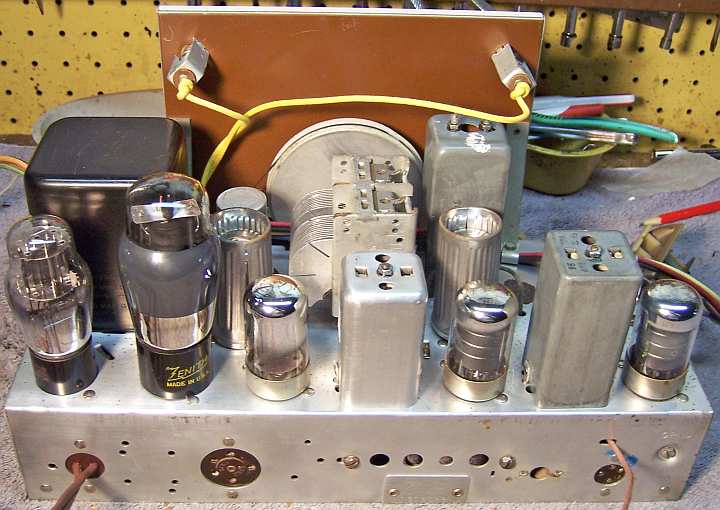
This example had seen minimal servicing in the past. I decided to reverse previous repairs to the extent possible.
The schematic for the Zenith 7-S-530 can be found on Nostalgia Air. Any part numbers will refer to numbers on that schematic.
 |
The Zenith model 7S530 (7-S-530, 1941 model year) is a tabletop
7-tube AC superhet circuit radio.
It receives the standard broadcast band and two short wave bands, and has
"automatic" or push-button tuning and the Zenith RadiOrgan tone
control system. This example had seen minimal servicing in the past. I decided to reverse previous repairs to the extent possible. The schematic for the Zenith 7-S-530 can be found on Nostalgia Air. Any part numbers will refer to numbers on that schematic. |
My antique radio restoration logs
The 6F6G, 7A4, and 7B4 tubes were branded Zenith and likely originals. The remainder were other brands and thus replacements.
The 6X5G had been replaced with a 6X5GT
The 1232/7G7 had been replaced by a 7V7.
C20, part number 22-1036C (14mfd/450 volts) had been replaced. The other filter capacitor was still in place. All the wax-paper capacitors were original.
All resistors were original.
The power cord had been replaced and the power line antenna removed.
The pilot lamps had been replaced by #47 (should be #44).
The cabinet finish, grille cloth, and knobs were original and in fair condition. The dial glass was intact, although the rubber gasket extrusion was falling apart. The cabinet back was intact, but damaged and parts of it were missing. There were several areas where cabinet veneer was loose and there were several chips. But is did display well. The chassis was very dirty, but had minimal rust. Virtually all the wiring was rubber covered and falling apart.
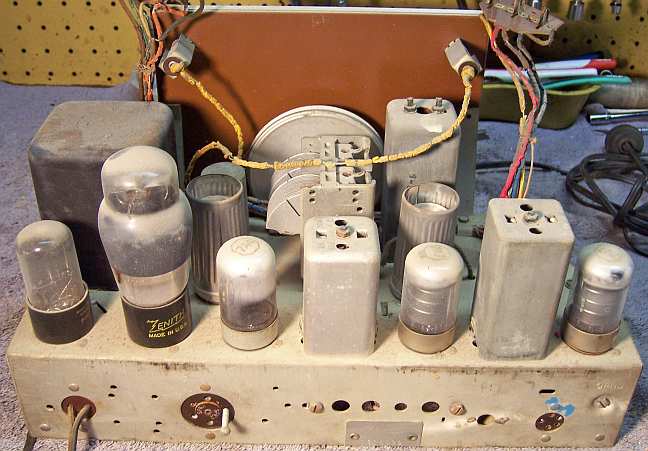
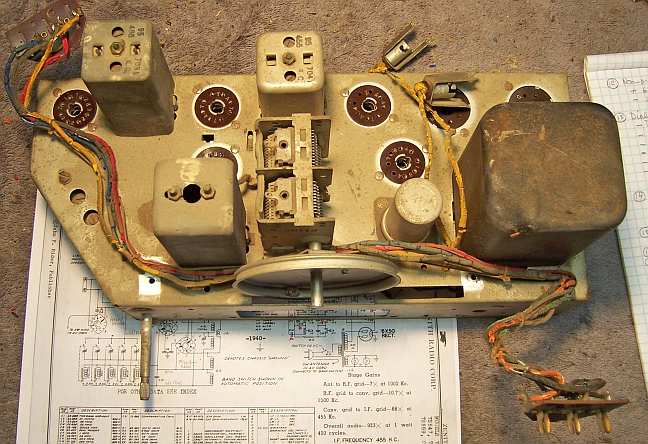
My usual restoration procedure is to first make a complete survey of the condition of all components. The survey results guide my restoration strategy. If major and unique components are defective or missing and cannot be restored or replaced, I may elect to sell the radio rather than restore it. I always assume that all paper and electrolytic capacitors are leaky and thus should be replaced (I always "restuff" the original containers if possible). Any mica capacitors are assumed OK until testing proves otherwise.
The automatic tuning unit (push button assembly) was first disconnected and removed in order to prevent damage to the fragile coils during handling the chassis. Fortunately, only four wires had to be disconnected. I found:
I first removed the non-original C20 capacitor. All tubes and shields were removed. The tuning capacitor was then removed for cleaning access to the chassis, and to replace the mounting grommets (I used standard 5/16" rubber grommets). I then took photos of the chassis bottom so that routing of wiring and component placement could be restored. Lead dress is often critical in radios. When I replace a component, I always remove the original part completely from a terminal. Other components connected at the terminal are protected from heat using old medical clamps (hemostats). Excess solder is then removed using a solder sucker in order to expose terminal holes for reattachment of the rebuilt or replaced component.
The top of the chassis was cleaned with GoJo hand cleaner and 00 steel wool. The tuning capacitor was cleaned in an old Heathkit ultrasonic cleaner with dilute ammonia. After drying, the bearings were lubed with automotive distributor cam grease.
The open output transformer replaced. It was mounted on the speaker basket. In order to estimate the required ratio, I measured the speaker voice coil resistance. It was 3.5 ohms. I estimated its impedance as 4 ohms. The required tube manual load impedance for the 6F6G output tube is 7000 ohms. Thus, the ratio needed is 41.8 (square root of 7000/4). I checked my spare parts box for used transformers which had a compatible mounting methods and were about the same physical size and similar ratio. I decided to use a Zenith 95-2346-AS, which had a ratio of 38.42. After the transformer was installed on the speaker and connected, the resulting impedance was measured at 5.47K ohms. This should be close enough! I measured the impedance by connecting a carefully measured 5K resistor in series with the output transformer primary and driving the combination with about 25 volts at 400hz from my HP200 audio oscillator. The impedance can then be estimated using simple voltage measurements across the resistor and transformer using ratios. I have no clue what the Zenith 95-2346 transformer was used in originally.
The bottom cover for the automatic tuning unit had become detached and was found in the cabinet. It was reattached using a patch cut from a file folder (not visible).
I found an exact replacement for R17 (15K, 1 watt, old style carbon composition) in my parts stock which was good (measured 14.9K!)
All the original Zenith paper capacitors were rebuilt in their original cases using modern 630 volt film capacitors in order to maintain the original under-chassis appearance. Here is the process I use. I reseal the cardboard tubes using rosin salvaged from RCA catacombs (it melts at a low temperature and will not damage the replacement capacitors. C14 (500pf, 600 volts) was restuffed using two 0.001mfd film capacitors in series. They fit end to end inside the case - just barely! Only certain brands of film capacitors are small enough for this application.
One original capacitor had been replaced: C20, part 22-1036C (14mfd/450 volts). Fortunately, I had a photo of an original capacitor from a previous restoration of this same chassis (Zenith 7S529). I found a suitable dud capacitor and clamp which was the correct size in my dud capacitor stock. A reproduction label was constructed using MS Word, with the correct lettering and approximate color. The dud capacitor case was cleaned out and restuffed using a new 15mfd/450 volt capacitor. Here is an original and my reproduction:
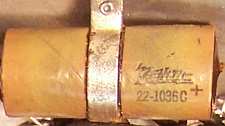 |
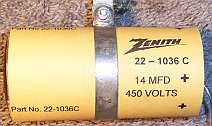 |
C18/C19, a chassis mount FP twist lock type capacitor, was restuffed. The original was 5mfd/450 volts plus 15mfd/350 volts. It was restuffed using new 4.7mfd and 15mfd, 450 volt capacitors. The original can was restuffed using the following technique:
Most of the original rubber covered wiring had to be replaced. The insulation would crumble and fall off if the wiring was moved even the slightest amount. A few wires between the bandswitch and coils were left in place, since they did not have to be disturbed. The cables to the tone control panels had to be replaced, as well as the wiring to both IF transformers. The power cord was replaced by a new brown vinyl cord. A wire lead was connected to the bandswitch and routed through the rear chassis to replace the now missing short wave antenna. Unless this is done, there will be virtually NO short wave reception (the original lead was likely about six feet long). Here are the dud parts and wiring replaced:
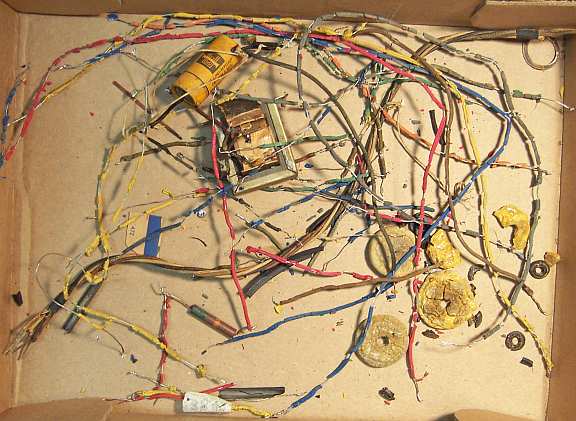
A new 6X5G tube was installed to replace the existing 6X5GT. The 7V7 tube was left in place since it is listed as an acceptable substitute for a 7G7. The 7B8, 7A4, and 7B4 tubes were replaced by stronger tubes (the 7B8 replacement was branded Zenith).
Once the radio was reassembled and the tubes installed, power was brought up slowly using a variac. AC power consumption was monitored using a watt meter, and a DVM monitored the B+. The radio powered up fine but there was initially no reception. The 7A7 IF amplifier tube was not lighting up (it tested good). The problem was the usual corrosion of tube pins typical of loctal tubes. Once that was remedied, the radio worked. It was then aligned. The volume control was a bit dodgy in places. It was usable, but slightly intermittent and noisy at low volume levels. These controls are virtually impossible to replace, since they have two tone taps and a small diameter long shaft. I just left it in place (it was cleaned with Big Bath spray cleaner, but that did not help).
The set was then aligned - no surprises. The push buttons were adjusted to local stations without difficulty. The set worked well on all bands, and the RadiOrgan tone control operated correctly. Except that this radio had the usual problem of excessive speaker cone excursion and resulting distortion with certain types of music if the LOW BASS control is engaged. I have seen this with other Zeniths of this vintage.
|
Chassis Before Restoration |
Chassis After Restoration |
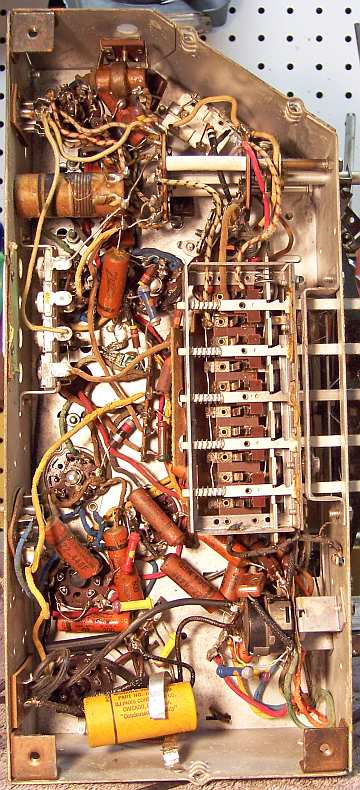 |
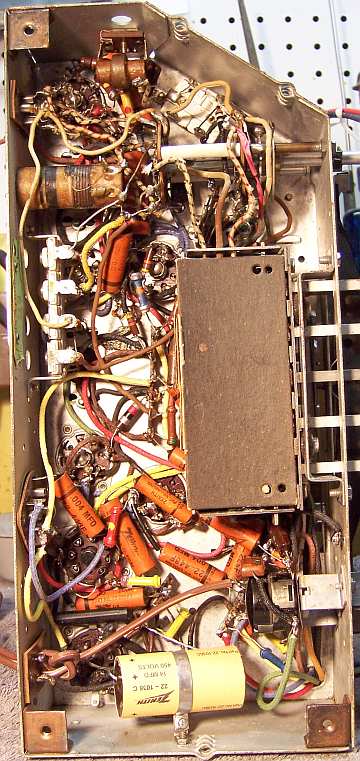 |
